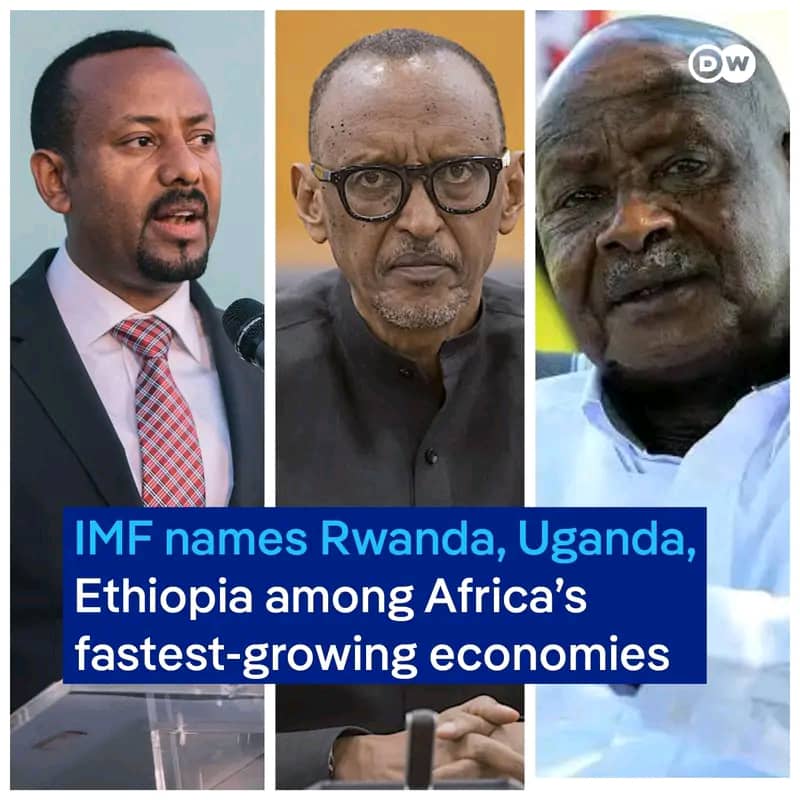IMF Highlights Strategic Reforms and Infrastructure Investments Driving Growth Amid Global Challenges
By Burnett Munthali
In a significant shift in Africa’s economic landscape, Rwanda, Uganda, Ethiopia, Benin, and Ivory Coast have emerged as the continent’s fastest-growing economies, according to the International Monetary Fund (IMF). The IMF’s October 2025 Regional Economic Outlook attributes this remarkable growth to a combination of sustained policy reforms, prudent fiscal management, and substantial investments in infrastructure and manufacturing sectors.
These nations are not only outperforming their regional counterparts but are also setting benchmarks for economic resilience and development in Sub-Saharan Africa. Their success stories offer valuable insights into how strategic governance and targeted investments can catalyze rapid economic transformation.
Rwanda: A Model of Visionary Leadership and Economic Diversification
Rwanda’s economic ascent is a testament to the power of visionary leadership and strategic planning. Under the guidance of President Paul Kagame, the country has implemented a series of reforms aimed at fostering a conducive environment for business and investment. These include streamlining regulatory processes, enhancing transparency, and investing in human capital development.
Key sectors driving Rwanda’s growth include agriculture, tourism, and manufacturing. The government has invested heavily in infrastructure projects, such as the expansion of Kigali International Airport and the development of industrial parks, to support industrialization and attract foreign direct investment. Additionally, Rwanda’s commitment to environmental sustainability has bolstered its appeal as a destination for eco-tourism, contributing significantly to its GDP.
According to the IMF, Rwanda’s GDP growth is projected at 7.1% in 2025, reflecting the effectiveness of its development strategies and the resilience of its economy.
Uganda: Leveraging Natural Resources and Strategic Investments
Uganda’s economic growth is underpinned by its rich natural resources and strategic investments in infrastructure and human capital. The discovery of oil reserves has provided a new avenue for economic expansion, with the government focusing on developing the necessary infrastructure to support the oil industry and related sectors.
In addition to the oil sector, agriculture remains a cornerstone of Uganda’s economy. The government has implemented policies to enhance agricultural productivity, including the provision of modern farming equipment and access to markets for farmers. Furthermore, investments in education and healthcare have improved human capital, leading to increased productivity across various sectors.
The IMF projects Uganda’s GDP growth at 7.2% in 2025, reflecting the positive impact of these strategic investments and policy reforms.
Ethiopia: Overcoming Challenges Through Structural Reforms
Ethiopia’s economic trajectory has been marked by significant reforms aimed at transforming its economy from one primarily based on agriculture to a more diversified industrial economy. The government has invested in infrastructure projects, such as the Grand Ethiopian Renaissance Dam, to provide reliable energy for industrial activities.
Despite challenges, including security concerns and a growing parallel foreign exchange market, Ethiopia has made strides in implementing structural reforms. These include tightening monetary policy, reducing inflation, and implementing tax and subsidy reforms. The country has also focused on improving its export sector, with export revenues projected to rise to 12% of GDP in the fiscal year 2024/25.
The IMF projects Ethiopia’s GDP growth at 6.6% in 2025, indicating the positive effects of its reform agenda and the resilience of its economy.
Benin: Harnessing Governance Reforms for Economic Growth
Benin’s economic growth is largely attributed to governance reforms and efforts to improve the business environment. The government has implemented measures to reduce corruption, enhance transparency, and streamline regulatory processes, making it easier for businesses to operate.
These reforms have attracted both domestic and foreign investment, particularly in sectors such as agriculture, manufacturing, and services. The country has also invested in infrastructure projects, including the development of ports and transportation networks, to facilitate trade and economic integration.
The IMF projects Benin’s GDP growth at 7.0% in 2025, reflecting the positive impact of its governance reforms and investment climate improvements.
Ivory Coast: Capitalizing on Infrastructure Development and Regional Integration
Ivory Coast’s economic growth is driven by infrastructure development and regional integration initiatives. The government has invested in transportation networks, energy projects, and industrial zones to support economic activities and attract investment.
Additionally, Ivory Coast has actively participated in regional integration efforts, such as the African Continental Free Trade Area (AfCFTA), to enhance trade and economic cooperation with neighboring countries. These initiatives have opened new markets for Ivorian products and facilitated the flow of goods and services across borders.
The IMF projects Ivory Coast’s GDP growth at 6.4% in 2025, indicating the effectiveness of its infrastructure development and regional integration strategies.
Comparative Analysis: Exclusion of Major Economies
Notably, major African economies such as Nigeria and South Africa are absent from the IMF’s list of fastest-growing economies. Nigeria, despite its vast oil reserves, faces challenges related to oil price volatility, governance issues, and infrastructural deficits, which have hindered its economic performance.
South Africa, as the continent’s most industrialized economy, grapples with structural inefficiencies, policy uncertainties, and high unemployment rates, which have contributed to its slower economic growth. These contrasts underscore the importance of effective governance, strategic investments, and economic diversification in achieving sustained economic growth.
Broader Implications for Sub-Saharan Africa
The economic successes of Rwanda, Uganda, Ethiopia, Benin, and Ivory Coast offer valuable lessons for other nations in Sub-Saharan Africa. They demonstrate that with sound policies, strategic investments, and a commitment to reform, countries can overcome challenges and achieve rapid economic growth.
However, the IMF also cautions that these gains are not guaranteed. The region faces ongoing challenges, including external shocks, climate change, and political instability, which could undermine progress. Therefore, it is crucial for governments to maintain momentum in implementing reforms, investing in infrastructure, and fostering inclusive economic growth.
Conclusion: A Roadmap for Sustainable Growth
The experiences of Rwanda, Uganda, Ethiopia, Benin, and Ivory Coast highlight the potential for Sub-Saharan Africa to achieve sustainable economic growth. By focusing on governance reforms, infrastructure development, and economic diversification, countries can build resilient economies capable of withstanding global challenges.
As the continent continues to navigate the complexities of the global economic landscape, the lessons from these nations provide a roadmap for others seeking to unlock their economic potential and contribute to Africa’s broader development goals.
Here’s a detailed personal opinion based on the article above:
Opinion: Africa’s Fast-Growing Economies Offer a Blueprint for Transformation
The IMF report highlighting Rwanda, Uganda, Ethiopia, Benin, and Ivory Coast as Africa’s fastest-growing economies is both encouraging and thought-provoking. In my view, these nations demonstrate that sustainable growth in Africa is not merely about natural resources or size of the economy, but about the quality of governance, policy consistency, and strategic investment.
Rwanda, for example, shows how visionary leadership combined with deliberate investments in infrastructure and human capital can transform a country’s economic prospects. Its focus on industrial parks, eco-tourism, and ease of doing business has set a benchmark for other African nations, proving that strong institutions and strategic planning can overcome historical limitations.
Uganda’s example reinforces the importance of leveraging natural resources responsibly while simultaneously investing in human capital. The balance between resource exploitation and development of agriculture, education, and healthcare illustrates a holistic approach to growth, one that ensures benefits are widely shared rather than concentrated in a few sectors or regions.
Ethiopia, despite its internal challenges, demonstrates that structural reforms can generate tangible economic results. By focusing on industrialization, energy infrastructure, and export growth, the country is diversifying away from traditional reliance on agriculture. This is a crucial lesson for other African nations still heavily dependent on single sectors.
Benin and Ivory Coast also highlight the often-overlooked role of governance reforms, transparency, and regional integration in driving growth. Their success underscores that macroeconomic stability, anti-corruption measures, and regional trade partnerships are equally vital as physical infrastructure projects.
What stands out to me is the contrast with Nigeria and South Africa. Both are large, resource-rich economies, yet they are absent from the fastest-growing list. This stark comparison underscores a critical truth: natural resources alone do not guarantee growth. Policy mismanagement, corruption, and failure to diversify the economy can stall even the most resource-abundant countries.
In conclusion, the growth of these five nations should serve as a blueprint for the rest of Africa. The lessons are clear: strong institutions, strategic investments, good governance, and diversification are more important than size or resource endowment. African countries that can replicate these principles stand a real chance of achieving sustainable growth and improving the living standards of their citizens.
I firmly believe that if nations across the continent take these examples seriously and adapt them to local contexts, Africa could enter a new era of economic transformation, where growth is inclusive, resilient, and sustainable.
Note: The information provided in this article is based on the latest available data and projections from the International Monetary Fund (IMF) and other reputable sources as of October 2025.





It’s heartwarming to see Rwanda, Uganda, Ethiopia, Benin, and Ivory Coast lead with smart reforms and infrastructure, and I hope this momentum brings real benefits to people. Keep going with such thoughtful progress.